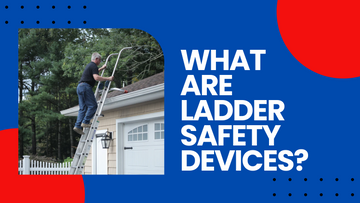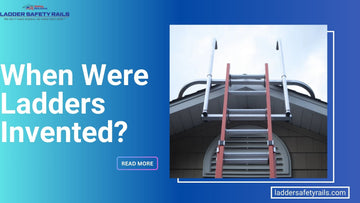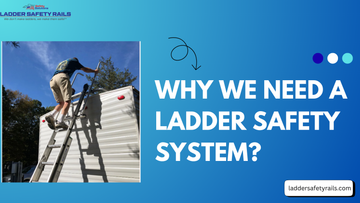
Have you ever felt a little nervous while climbing a ladder, even just to change a light bulb or reach a high shelf, or just getting on and off a roof top? It might seem simple, but using a ladder can sometimes be risky if you're not careful. A small slip or shake can lead to big trouble, which can cause a life altering impact.
That’s why ladder safety is so important and luckily, there are special tools made just for this. These tools are called ladder safety devices. They help make climbing safer, steadier, and more secure.
But what exactly are these devices, and how do they work? Let’s explore the basics and see how they can make a big difference.
Understanding Ladder Safety Devices: The Basics
Ladder safety devices include a wide range of attachments and accessories that improve ladder stability, prevent misuse, and reduce fall risks. These devices are part of a broader ladder safety system, which also includes user practices, physical supports, and protective gear.
The Occupational Safety and Health Administration (OSHA) and ANSI standards require various safety measures on fixed and portable ladders, especially when climbing heights over 24 feet. But guess what? Even a 6-foot ladder can cause serious injury without the right precautions.
Common devices include:
|
Device Type |
Purpose
|
Common Use Case
|
|
Fall Arrest System
|
Prevents free falls
|
Industrial climbing systems
|
|
Ladder Stabilizers
|
Prevent tipping
|
Outdoor painting, roof access
|
|
Safety Rails
|
Offers handholds and boundaries
|
Extension ladder transitions
|
|
Ladder Levelers
|
Adjusts for uneven ground |
Yard and garden work
|
|
Cage Systems |
Protects against lateral falls
|
Permanent fixed ladders
|
By integrating these tools into your workflow, you’re not just following ladder safety rules—you’re proactively protecting yourself or your team.
Ladder Stabilizers: Prevent Side Slips and Wall Damage

A ladder stabilizer attaches to the top of an extension ladder and increases its footprint, providing a wider, more stable base. This reduces side-to-side movement and prevents the ladder from damaging gutters, walls, or windows.
Stabilizers are vital when working on uneven ground or tall structures—places where even a minor slip can be catastrophic. They’re particularly useful in residential roofing, exterior painting, and window washing jobs.
Some models come with non-marring rubber ends, so they won’t scuff surfaces. Others fold for easier transport. Lightweight yet rugged aluminum designs are ideal for contractors and homeowners alike.
Pro Tip: Combine a stabilizer with a safe ladder angle (around 75 degrees) for best results.
Ladder Safety Rails: Climb with Confidence
Ladder safety rails provide side support, acting as both a guide and a physical barrier. They're especially helpful during the transition between the ladder and the rooftop or upper level—a moment when many falls occur.
For extension ladder safety, add-on rail systems are game changers. Some extend above the roofline and offer built-in grab handles. Ladder rails are often made of high-strength aluminum or fiberglass, and some can be permanently mounted to the ladder itself. They're a must-have for anyone who regularly works on rooftops or raised platforms.
Fall Arrest and Climbing Systems: Industrial-Grade Safety
In commercial settings or at heights above 24 feet, OSHA mandates ladder safety devices like fall arrest systems. These include:
-
A vertical lifeline or cable
-
A harness worn by the climber
-
A rope grab or cable trolley that slides with you
This ladder safety system ensures that if you slip, the arrest mechanism locks instantly, halting your fall. These setups are often seen on communication towers, water tanks, and industrial sites.
While these may be overkill for a quick job around the house, they’re critical in professions that demand daily vertical travel.
Ladder Levelers: Master Uneven Terrain
A ladder on a slope is an accident waiting to happen. Ladder levelers attach to the bottom legs and can be adjusted to compensate for sloped ground, stairs, or uneven surfaces.
Most modern levelers are tool-free and can be locked into place in seconds. Some are integrated into ladder legs, while others are bolt-on accessories. Either way, they drastically reduce wobble and the risk of sudden tipping.
Working on landscaping, yard maintenance, or exterior housework? Levelers are your best friend.
Ladder Safety Tips Everyone Should Know
Even with the best gear, it is important to use it properly. Here are some ladder safety rules that apply across all situations:

Top 5 Ladder Safety Tips
-
Inspect your ladder before every use. Look for cracks, bends, or missing rungs.
-
Keep a 3-point contact: two hands and one foot or two feet and one hand.
-
Set the ladder at the safe ladder angle—a 4:1 ratio (for every 4 feet up, move the base 1 foot out).
-
Never stand on the top rung. It’s not a step, no matter how tempting it looks.
-
Avoid carrying heavy tools while climbing. Use a tool belt or hoist line.
Following these simple guidelines can prevent 90% of ladder-related injuries.
Conclusion:
Whether you're patching a roof, cleaning gutters, or scaling industrial heights, ladder safety devices are non-negotiable. They're not just add-ons—they’re lifesavers.
Stay secure on every climb and discover the best tips and tools at Ladder Safety Rails, and learn how to choose the right ladder, follow proper sizing charts, and avoid common risks.
FAQs:
-
Which is the safest device to use while climbing?
The safest device for climbing, especially at heights above 24 feet—is a ladder safety system. It includes a harness, a lifeline, and a locking mechanism that stops falls instantly.
-
What is a ladder stability device?
A ladder stability device is any accessory that improves a ladder’s balance and prevents tipping or sliding. The most common types are ladder stabilizers and ladder levelers. These tools increase the ladder's footprint or adapt it for uneven surfaces, making it safer to use.
-
What are examples of ladder safety systems?
Examples of ladder safety systems include; Ladder stabilizers and Ladder safety Bumpers. These components work together to prevent falls and improve user stability.
-
Is a ladder stabilizer worth it?
Absolutely, a ladder stabilizer adds extra width and grip, preventing side movement and protecting surfaces like gutters or siding. It’s especially useful for extension ladder safety during roofing, painting, or cleaning tasks.
-
Can you use a ladder without a stabilizer?
Yes, you can use a ladder without a stabilizer—but it’s not recommended for elevated tasks or uneven ground. Without one, your ladder is more prone to slipping, especially on slick or angled surfaces.
Read More Blogs Here:

5 Tips for Safely Setting Up Your Ladder on a Sloped Roof




